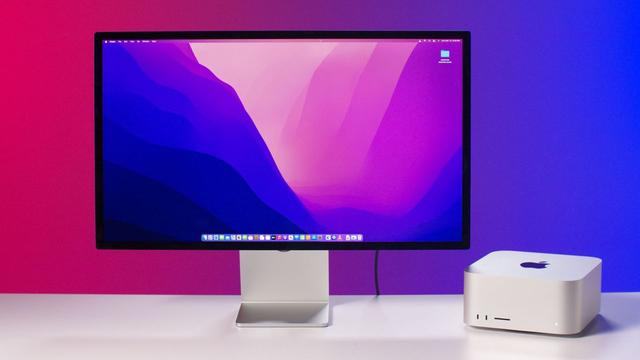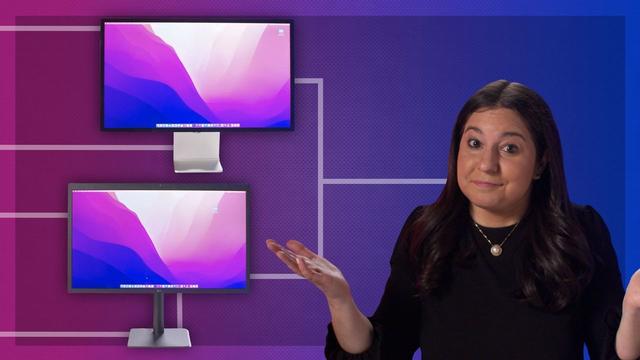
Apple’s Studio Display is the ultimate home office monitor — if you can pay $1,599
Apple’s Studio Display monitor is effectively an iMac with the computer part ripped out — and for some, that could be a very good thing. This high-end display packs a gorgeous 5K screen for creative work and casual bingeing, but it really stands out with an excellent webcam, microphone and speakers that allow it to serve as an all-in-one home office powerhouse.
However, all of that functionality comes at a steep $1,599 starting price, and it has a few notable drawbacks compared to some cheaper monitors. So is the Studio Display worth the splurge? Here’s what I think after using it as my main work (and play) monitor for a week.
Apple Studio DisplayA premium monitor for creatives and WFHersThe Apple Studio Display combines a gorgeous 5K screen with an excellent webcam, microphone and speaker set for video calls and multimedia.
$1,599 at Best Buy$1,599 at Adorama$1,599 at AppleThe who, what and how
Who it’s for: Apple’s Studio Display is best suited for creatives who want a high-quality 5K screen for serious photo and video editing. It’s also great for anyone who works from home, thanks to an excellent integrated webcam, speaker set and microphone. It’s primarily made for Mac users, and using it with a Windows PC won’t give you access to all features.
What you need to know: The Studio Display packs a 27-inch 5K Retina screen, which is great for both creative visual work and bingeing your favorite TV shows. It also gets you a 12-megapixel camera with Center Stage, a six-speaker sound system and a three-microphone array, all of which impressed in our testing. The Studio Display connects to Macs and PCs via Thunderbolt 3, and can even charge up your MacBook while connected.
How it compares: The Studio Display isn’t nearly as expensive as Apple’s $4,999 Pro Display XDR, which has a larger and sharper 32-inch 6K Retina display. Despite its bigger size and better resolution, the XDR lacks an integrated webcam and speaker set and doesn’t even ship with a stand, so you’ll be choosing between a versatile prosumer display and one designed for heavy-duty visual work. The Studio Display is pricier than competing 5K monitors like the $1,296 LG UltraFine 5K, which also has an integrated webcam and speakers.
A sleek design with some notable drawbacks
The Studio Display has a clean, minimalist design that looks like a 27-inch iMac with all of the fat trimmed off. The svelte 14-pound display was relatively easy to lug over to my desk, and its sleek silver exterior makes a nice complement to the Mac Studio I’ve had tucked under it for the past week or so.
Apple’s 27-inch monitor packs four USB-C ports in the back: one Thunderbolt 3 connection for hooking up your Mac, and three downstream USB-C ports for things like peripherals and storage drives. The monitor worked instantaneously with both my Mac Studio and 14-inch MacBook Pro via the included Thunderbolt cable, and was even able to fast charge the latter (about 50% of battery in 30 minutes) while I had it connected. The Studio Display also worked well with my Dell XPS 13 complete with the same camera, speaker and charging support, though certain features — such as Center Stage and Spatial Audio — are exclusive to Macs.
The Mac Studio is compact, cool and crazy powerful — but who’s it for?
I found the Studio Display’s ports sufficient overall, and appreciated the three USB-C connections for charging up my iPhone 12 Pro and Beats Fit Pro while I worked. Still, it would have been nice to have an HDMI connection, which would add some extra value to the Studio Display as a mini 5K TV for use with streaming sticks and boxes. And if you’re a power user who switches between multiple machines on the same display, note that the Studio Display can connect to only one computer at a time via the lone Thunderbolt 3 port.

I tested the base Studio Display with a tilt-adjustable stand that offers 30 degrees of movement, and rocking the display back and forth as needed felt smooth and secure. I just wish you didn’t have to pay an extra $400 for a tilt- and height-adjustable stand, which adds about 4 inches of height adjustment. And if you want to mount the Studio Display to a wall, desk or arm, you’ll have to swap the tilt stand for a VESA mount adapter option at the point of purchase for the same starting price of $1,599.
None of these stands or adapters are removable or interchangeable, so you’ll have to make sure you get the model that fits best with your setup from the start. This is especially disappointing considering that cheaper monitors, like our top 4K pick in the $589 Dell UltraSharp 27, offer all of these adjustment options in one — plus the ability to pivot to vertical orientation.
A beautiful 5K screen for work and play
The Studio’s 27-inch 5K Retina panel is a thing of beauty. Even just scrolling through Twitter and typing up documents on the Studio Display was a delight, thanks to deep blacks and strong contrast that made text look satisfyingly inky. But Apple’s monitor really shines once you dive into some high-resolution pictures or fire up your favorite TV show.
When browsing through a Photos gallery shot on professional cameras, I was immediately struck by the bold hues and staggering amount of detail I could make out. A shot of a woman lying in a bed of flowers was bursting with eye-popping reds and greens on Apple’s monitor, which also allowed me to see the most minute facial details — down to individual pores and beads of sweat — when viewing close-up portraits. Everything from a purple, starry night sky to a dramatic orange sunset looked captivatingly colorful, something that should give photographers a great canvas for viewing and editing their shots.
The Studio Display was just as impressive when it came time to kick back and binge some TV. I could make out every bead of sweat and scraggly gray hair on Tom Hanks’ face when streaming “Finch” on Apple TV+, and the show’s muted oranges and reds looked appropriately dystopian on Apple’s monitor. An 8K nature video on YouTube looked especially arresting on Apple’s monitor — the lush greenery and vibrant blue skies popped off of the screen, and everything from the individual scales of a snake to a lion’s whiskers came through in vivid detail.
The Studio Display remained impressively bright and viewable throughout my testing time, and I didn’t notice much glare on its glass display. If your workspace is heavy on harsh environmental sunlight, you can upgrade to a nano-texture glass option built specifically for minimizing reflections for $1,899.
Apple’s monitor also packs a variety of display presets you can toggle in the settings menu (including HDTV Video, Digital Cinema and Photography), ensuring that professional photo and video editors can properly work within the color range that their projects require. You also get the same True Tone technology found on the latest iMacs and MacBooks, which allows the display to automatically adapt to the room you’re in to provide the most accurate color temperature possible at all times.
A true multimedia monster
The Studio Display will make your photos and videos look great, but it’s more than just a pretty screen. This monitor’s built-in webcam, speakers and microphone are all exceptional, making the Studio Display an all-in-one multimedia monster that could be the only accessory you need on your desk.
The Studio’s 12-megapixel ultrawide camera is one of the best webcams I’ve ever used, capturing the finer details of my messy beard while making my skin tone and clothing look bright and accurate. Even the Logitech C920 — our favorite webcam — couldn’t keep up with Apple’s integrated camera, producing shots that looked washed out and less detailed by comparison.
The Studio Display’s camera also supports Center Stage, the same auto-framing technology that you’ll find on the latest iPad Pro and iPad Air. It’s a really neat party trick to see in action, and it did a good job following me around and keeping my face centered — even when I stood up — during Zoom and Webex calls. While I can see Center Stage being distracting for some folks on the other end of a call, it’s a handy tool for folks who are especially active talkers, or if you find yourself having to stand up and move around while giving a presentation.
The six-speaker sound system on this monitor is likewise excellent, filling my room with rich, booming audio for movies and music alike. Everything from the bumping, bassy pop music of Muna to the somber guitar plucks and whispery vocals of Phoebe Bridgers came through with striking clarity, making me instantly bob my head and get in my feelings, respectively. These speakers also support Spatial Audio, a feature that allowed me to easily pinpoint the placement of specific instruments — such as a drum rattle on the left or a banjo riff on the right — when listening back to a Logic Pro session of Lil Nas X’s “Montero.”
The Studio Display’s three-microphone array was more than sufficient for my daily video calls, to the point where one colleague called out how clear I sounded. The voice recordings I captured in GarageBand were impressively close in quality to my dedicated HyperX QuadCast S microphone, though the latter was more crisp and picked up less background noise. I even recorded some quick acoustic guitars and vocals on the Studio Display’s built-in speakers, and while I wouldn’t call it studio-quality, the result was good enough for basic demoing.
This display’s camera and audio quality largely lines up with the great experience I had with the 2021 iMac, which is impressive considering that monitors rarely have good webcams or speakers — if any at all. I never got the urge to reach for my usual webcam, microphone or computer speakers during my time with the Studio Display, which allowed me to maintain a clean workspace.
Bottom line
If you’re willing to pay its high asking price, the Studio Display has just about the best combination of picture quality and features I’ve ever seen on a monitor. Its 5K Retina display looks truly beautiful whether you’re thumbing through professional photos or streaming TV shows, and its svelte design and plug-and-play Thunderbolt 3 port allow it to play nice with most setups. The Studio Display also gets you an excellent webcam, speakers and microphone, which would likely cost you a few hundred bucks if purchased separately.
Still, $1,599 is a lot of money, and there are plenty of worthwhile alternatives out there. If all you want is a good-looking 27-inch display, Dell’s UltraSharp 27 is our top 4K pick and a fraction of the price at $589. There’s also the LG UltraFine 5K, which packs a similar feature set — including an integrated webcam and speakers — for a cheaper $1,296.
If you don’t already have a Mac or are ready to upgrade, it’s also worth noting that you can get the latest 24-inch iMac — a complete all-in-one computer — for less than the price of this monitor at a starting $1,299. You’ll get a similarly excellent picture quality, webcam, speakers and microphone, all within a zippy Apple M1-powered machine that’s great for most tasks.
But if you already have a good computer and are looking to pair it with an equally high-end display for photo and video editing — and spend lots of time on video calls — the Studio Display is a gorgeous and versatile addition to the home office for anyone willing to splurge on one.
}})